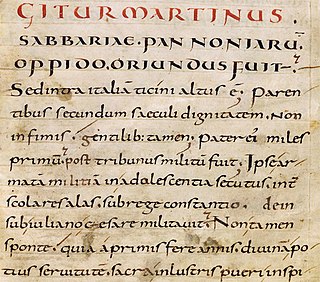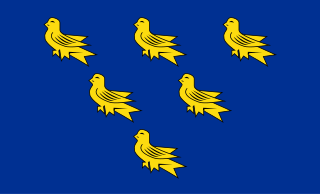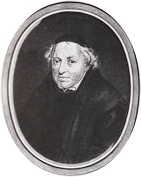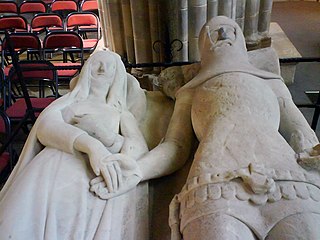Ralph Bocking [lower-alpha 1] (died 1270), was an English Dominican friar and a native of Chichester, Sussex. He was known for being Saint Richard's confessor, friend and ultimately his biographer.
Ralph Bocking [lower-alpha 1] (died 1270), was an English Dominican friar and a native of Chichester, Sussex. He was known for being Saint Richard's confessor, friend and ultimately his biographer.
Bocking was a Dominican friar and hagiographer. A native of Chichester, he was a friend and private confessor of Richard of Chichester. Not much is known about Bocking other than what he reveals about himself in Richard's biography. [2] Richard held the see of Chichester from 1245 till his death in 1253. [3] The canonization of Richard in 1262 provided materials that allowed Bocking to compile a biography of the Saint. It is probable that his long association with Richard provided supplementary material for the biography. [4] After completing the biography Bocking wrote an addendum containing information on miracles attributed to the Saint. In the dedication he explained that he had written the Life by request of Isabel, countess of Arundel, and Robert Kilwardby (chief of the Dominican order in England, and afterwards archbishop of Canterbury). [5] The widowed countess of Arundel had, since her husband's death, devoted her life to piety, including the foundation of an abbey for nuns. Bocking commented that the countess had a vast collection of hagiography in her library. [4]
Bocking's thirteenth-century manuscript containing Richard's biography is housed in the British Museum (MS. Sloane, 1772, ff. 25–70). It was printed in the Bollandists Acta Sanctorum (acts of saints), 1675. under 3 April. A popular abridgment of Ralph's life by John Elmer, manuscripts of which are extant in the British Museum, in the Bodleian, and at York, is printed in Capgrave's 'Nova Legenda Angliæ.' fol. 269 b. Bale attributes to Ralph a series of sermons, but nothing is known of these sermons. [5]
Saint Richard is widely remembered today for a popular prayer, that he recited on his deathbed. [6] Bocking was present and transcribed the prayer and it is now recorded in the Acta Sanctorum. The modern version of the prayer, translated from the original Latin, [lower-alpha 2] is:
Day by day,
Dear Lord, of thee three things I pray:
To see thee more clearly,
Love thee more dearly,
Follow thee more nearly,
Day by Day.
Gratias tibi ago, Domine Jesu Christe, de omnibus beneficiis quae mihi praestitisti;
pro poenis et opprobriis, quae pro me pertulisti;
propter quae planctus ille lamentabilis vere tibi competebat.
Non est dolor similis sicut dolor meus.
(Acta Sanctorum. Vol 10. Tertia Aprilis. p. 281. Caput III. 18.)

Chichester Cathedral, formally known as the Cathedral Church of the Holy Trinity, is the seat of the Anglican Bishop of Chichester. It is located in Chichester, in West Sussex, England. It was founded as a cathedral in 1075, when the seat of the bishop was moved from Selsey.

Matthew Paris, also known as Matthew of Paris, was an English Benedictine monk, chronicler, artist in illuminated manuscripts and cartographer, based at St Albans Abbey in Hertfordshire. He wrote a number of works, mostly historical, which he scribed and illuminated himself, typically in drawings partly coloured with watercolour washes, sometimes called "tinted drawings". Some were written in Latin, others in Anglo-Norman or French verse.

A hagiography is a biography of a saint or an ecclesiastical leader, as well as, by extension, an adulatory and idealized biography of a preacher, priest, founder, saint, monk, nun or icon in any of the world's religions. Early Christian hagiographies might consist of a biography or vita, a description of the saint's deeds or miracles, an account of the saint's martyrdom, or be a combination of these.

Richard of Chichester, also known as Richard de Wych, is a saint who was Bishop of Chichester.

Sussex, from the Old English 'Sūþsēaxe', is a historic county in South East England.

Saint Cuthmann of Steyning, also spelt Cuthman, was an Anglo-Saxon hermit and church-builder.

Veridiana (Virginia Margaret del Mazziere) (1182 – 1 February 1242) is an Italian saint.

Daniel Papebroch, S.J., was a Flemish Jesuit hagiographer, one of the Bollandists. He was a leading revisionist figure, bringing historical criticism to bear on traditions of saints of the Catholic Church.

"An Arundel Tomb" is a poem by Philip Larkin, written and published in 1956, and subsequently included in his 1964 collection The Whitsun Weddings. It describes the poet's response to seeing a pair of recumbent medieval tomb effigies with their hands joined in Chichester Cathedral. It is described by James Booth as "one of [Larkin's] greatest poems". It comprises 7 verses of 6 lines each, each with rhyme scheme ABBCAC.

Clare of Assisi was an Italian saint and one of the first followers of Francis of Assisi. She founded the Order of Poor Ladies, a monastic religious order for women in the Franciscan tradition, and wrote their Rule of Life, the first set of monastic guidelines known to have been written by a woman. Following her death, the order she founded was renamed in her honour as the Order of Saint Clare, commonly referred to today as the Poor Clares. Her feast day is on 11 August.
St Richard's Catholic College, or St Richard's, is a secondary school in East Sussex in the United Kingdom. It is a voluntary aided school, maintained by East Sussex County Council. The school is situated in the Roman Catholic Diocese of Arundel and Brighton. St Richard's was rated 'outstanding' by Ofsted in 2006, a rating that it sustained following an interim assessment in 2010. Of the school community, HM Inspectorate commented, 'The social, moral, spiritual and cultural development of students is outstanding'. St Richard's also scored a Level 1 in each section of its 2018 Denominational Inspection Report.
Arundel Blackfriars, otherwise Dominican Priory, Arundel, was a friary of the Dominican Order in Arundel, West Sussex, England. The date of foundation was before 1253, when Saint Richard, bishop of Chichester, mentioned it in his will. The friary remained small and poor throughout its history. It was dissolved in 1538.
Religion in Sussex has been dominated over the last 1,400 years by Christianity. Like the rest of England, the established church in Sussex is the Church of England, although other Christian traditions exist. After Christianity, the religion with the most adherents is Islam, followed by Hinduism, Buddhism, Judaism and Sikhism.
The history of Christianity in Sussex includes all aspects of the Christianity in the region that is now Sussex from its introduction to the present day. Christianity is the most commonly practised religion in Sussex.
André Abellon, O.P. was a French Roman Catholic priest and a professed member from the Order of Preachers. He became a Dominican after hearing the preaching of Vincent Ferrer and studied art before joining their ranks. Abellon gained fame as a noted preacher and confessor but became a prominent figure after tending to victims of the plague in Aix-en-Provence in 1445. He was also a noted artist and painter with some of his works still surviving at present.
Sussex in the High Middle Ages includes the history of Sussex from the Norman Conquest in 1066 until the death of King John, considered by some to be the last of the Angevin kings of England, in 1216. It was during the Norman period that Sussex achieved its greatest importance in comparison with other English counties. Throughout the High Middle Ages, Sussex was on the main route between England and Normandy, and the lands of the Anglo-Norman nobility in what is now western France. The growth in Sussex's population, the importance of its ports and the increased colonisation of the Weald were all part of changes as significant to Sussex as those brought by the neolithic period, by the Romans and the Saxons. Sussex also experienced the most radical and thorough reorganisation of land in England, as the Normans divided the county into five tracts of lands called rapes. Although Sussex may have been divided into rapes earlier in its history, under the Normans they were clearly administrative and fiscal units. Before the Norman Conquest Sussex had the greatest concentration of lands belonging to the family of Earl Godwin. To protect against rebellion or invasion, the scattered Saxon estates in Sussex were consolidated into the rapes as part of William the Conqueror's 'Channel march'.

Charles Alban Buckler (1825–1905) was an English author, topographer, architect, artist and officer of arms. According to Historic England, he "became one of the most distinguished of the early to mid-Victorian Catholic architects." In the field of heraldry he was the Surrey Herald Extraordinary.